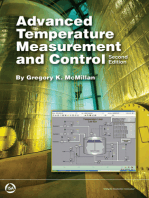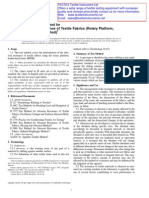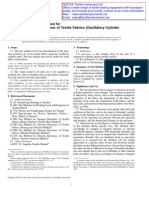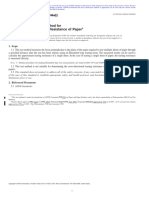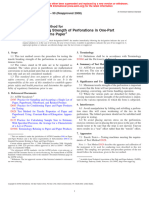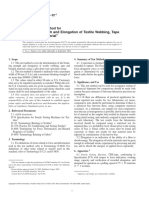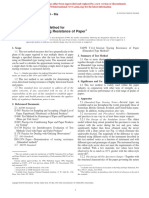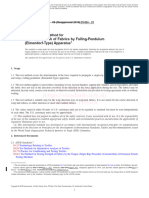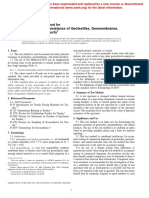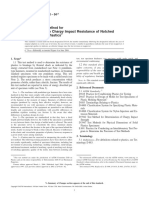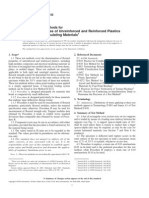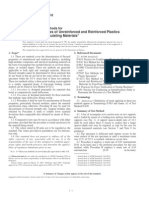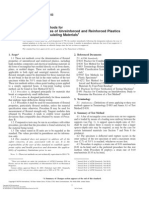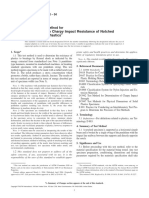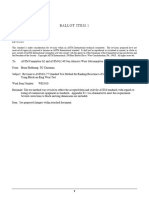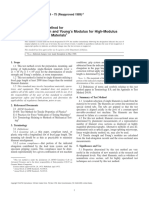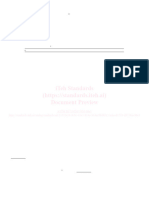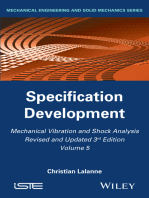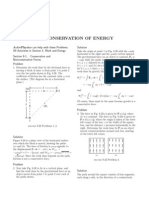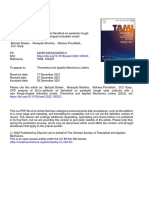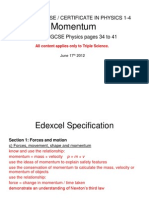0 ratings0% found this document useful (0 votes)
58 viewsInternal Tearing Resistance of Paper: Standard Test Method For
Internal Tearing Resistance of Paper: Standard Test Method For
Uploaded by
Angel ValladaresThis Test Method measures the force perpendicular to the plane of the paper. The measured results can be used to calculate the approximate tearing resistance of a single sheet. Similar procedures for making Elmendorf-type tear measurements are found in ISO 1974 and TAPPI T414.
Copyright:
© All Rights Reserved
Available Formats
Download as PDF, TXT or read online from Scribd
Internal Tearing Resistance of Paper: Standard Test Method For
Internal Tearing Resistance of Paper: Standard Test Method For
Uploaded by
Angel Valladares0 ratings0% found this document useful (0 votes)
58 views7 pagesThis Test Method measures the force perpendicular to the plane of the paper. The measured results can be used to calculate the approximate tearing resistance of a single sheet. Similar procedures for making Elmendorf-type tear measurements are found in ISO 1974 and TAPPI T414.
Original Title
D 689 - 96 _RDY4OS05NKE_
Copyright
© © All Rights Reserved
Available Formats
PDF, TXT or read online from Scribd
Share this document
Did you find this document useful?
Is this content inappropriate?
This Test Method measures the force perpendicular to the plane of the paper. The measured results can be used to calculate the approximate tearing resistance of a single sheet. Similar procedures for making Elmendorf-type tear measurements are found in ISO 1974 and TAPPI T414.
Copyright:
© All Rights Reserved
Available Formats
Download as PDF, TXT or read online from Scribd
Download as pdf or txt
0 ratings0% found this document useful (0 votes)
58 views7 pagesInternal Tearing Resistance of Paper: Standard Test Method For
Internal Tearing Resistance of Paper: Standard Test Method For
Uploaded by
Angel ValladaresThis Test Method measures the force perpendicular to the plane of the paper. The measured results can be used to calculate the approximate tearing resistance of a single sheet. Similar procedures for making Elmendorf-type tear measurements are found in ISO 1974 and TAPPI T414.
Copyright:
© All Rights Reserved
Available Formats
Download as PDF, TXT or read online from Scribd
Download as pdf or txt
You are on page 1of 7
Designation: D 689 96a
An American National Standard
Standard Test Method for
Internal Tearing Resistance of Paper
1
This standard is issued under the xed designation D 689; the number immediately following the designation indicates the year of
original adoption or, in the case of revision, the year of last revision. A number in parentheses indicates the year of last reapproval. A
superscript epsilon (e) indicates an editorial change since the last revision or reapproval.
1. Scope
1.1 This test method measures the force perpendicular to the
plane of the paper required to tear multiple sheets of paper
through a specied distance after the tear has been started,
using an Elmendorf-type tearing tester. The measured results
can be used to calculate the approximate tearing resistance of
a single sheet. In the case of tearing a single sheet of paper, the
tearing resistance is measured directly.
NOTE 1Similar procedures for making Elmendorf-type tear measure-
ments are found in ISO 1974 and TAPPI T414.
1.2 This test method is not suitable for determining the
cross-directional tearing resistance of highly directional boards
and papers.
1.3 This standard does not purport to address all of the
safety concerns, if any, associated with its use. It is the
responsibility of the user of this standard to establish appro-
priate safety and health practices and determine the applica-
bility of regulatory limitations prior to use.
2. Referenced Documents
2.1 ASTM Standards:
D 585 Practice for Sampling and Accepting a Single Lot of
Paper, Paperboard, Fiberboard, or Related Products
2
D 646 Test Method for Grammage of Paper and Paperboard
(Mass per Unit Area)
2
D 685 Practice for Conditioning Paper and Paper Products
for Testing
2
D 1749 Practice for Interlaboratory Evaluation of Test
Methods Used with Paper and Paper Products
2
E 178 Practice for Dealing with Outlying Observations
3
2.2 ISO Standard:
ISO 1974 PaperDetermination of tearing resistance
(Elmendorf method)
4
2.3 TAPPI Standard:
TAPPI T 414 Internal Tearing Resistance of Paper
(Elmendorf-Type Method)
5
3. Summary of Test Method
3.1 One or more sheets of the sample material are torn
together through a xed distance by means of the pendulum of
an Elmendorf-type tearing tester. The work done in tearing is
measured by the loss in potential energy of the pendulum. The
instrument scale is calibrated to indicate the average force
exerted when a certain number of plies are torn together (work
done divided by the total distance torn).
4. Signicance and Use
4.1 This test method is widely used within the paper
industry, in conjunction with other tests of strength, as a
predictor of end-use performance of a wide range of grades of
papers.
5. Apparatus
5.1 Elmendorf-Type Tearing TesterSeveral types are
available and in use throughout the world, principally those of
Australian, British, German, Swedish, and United States manu-
facture. In addition, testing practices also vary.
5.2 Instrumental and Procedural VariablesInstruments
and practices in use vary in at least three major respects:
5.2.1 The Design of the Pendulum SectorThe oldest
model without deep cutout permitted the specimen to come in
contact with the sector during the test and gave values
signicantly higher than those obtained using the newer
models with a deep cutout (see Fig. 1) which eliminate this
undesirable friction. The magnitude of the difference in value
obtained using different styles of the instrument described in
this test method varies as a function of instrument and with
different types and grammages of paper. The instrument having
the oldest-style sector does not meet the requirements of this
test method. With a few materials, test values have been
observed to be as much as 10 % greater with the oldest-style
sector (1)
6
.
5.2.2 The Design Of The Specimen ClampsTogether with
the structural characteristics of the paper governing the nature
1
This test method is under the jurisdiction of ASTM Committee D-6 on Paper
and Paper Products and is the direct responsibility of Subcommittee D06.92 on Test
Methods.
Current edition approved May 10, 1996. Published August 1996. Originally
published as D 689 42 T. Last previous edition D 689 96. Discontinued 1984
and reinstated 1992.
2
Annual Book of ASTM Standards, Vol 15.09.
3
Annual Book of ASTM Standards, Vol 14.02.
4
Available from American National Standards Institute, 11 W. 42nd St., 13th
Floor, New York, NY 10036.
5
Available from the Technical Association of the Pulp and Paper Industrial, P.O.
Box 105113, Atlanta, GA 30348.
6
The boldface numbers in parentheses refer to the list of references at the end of
this standard.
1
Copyright ASTM International, 100 Barr Harbor Drive, PO Box C700, West Conshohocken, PA 19428-2959, United States.
NOTICE: This standard has either been superceded and replaced by a new version or discontinued.
Contact ASTM International (www.astm.org) for the latest information.
of the tear with respect to its splitting tendencies during the
test, this has an appreciable inuence on the mode of tearing
and may result in signicant differences (2). The procedure
described in 5.3.7 reduces this effect. The clamp designs used
by some manufacturers may vary even for their own models.
Instruments are available with pneumatically activated grips as
well, which minimizes variations due to differences in clamp-
ing pressures exerted by manually tightened grips.
5.2.3 A Combined Variation in Testers and Testing
PracticesAs measured tearing resistance increases or de-
creases for different types of paper, the measurement may
become so large or so small as to be outside the practical range
of the instrument. This problem may be overcome in one of
two ways; the number of sample sheets tested at one time may
be changed, or the mass of the instrument pendulum may be
changed either by adding augmenting weights or by replacing
the entire pendulum with one of a different known mass. The
tearing length must never be varied in an effort to alter the
pendulum capacity.
5.2.4 These differences, together with other lesser differ-
ences in design details between instruments or testing prac-
tices, preclude specifying a tearing instrument and method that
would give essentially the same test results when using
Elmendorf instruments of different design and manufacture.
Even for one specic model, some procedural variables such as
the number of plies torn may alter the test values calculated on
a single sheet basis substantially. By necessity, this reference
method must be arbitrary and is limited to the described
procedure used with instruments conforming to all of the
requirements specied under 5.3.
5.3 Required Instrument for This Test Method:
5.3.1 Elmendorf Tearing Tester (3, 4, 5), with a cutout as
shown in Fig. 1, which prevents the specimen from coming in
contact with the pendulum sector during the test, and having
the following elements:
5.3.2 Stationary and Movable ClampThe movable clamp
is carried on a pendulum formed by a sector of a circle free to
swing on a ball bearing.
5.3.3 Knife, mounted on a stationary post for starting the
tear.
5.3.4 Means for Leveling the Instrument.
5.3.5 Pendulum HolderMeans for holding the pendulum
in a raised position and for releasing it instantaneously.
5.3.6 Means for Registering the Maximum Arc through
which the pendulum swings when released. The registering
means may consist of a graduated scale mounted on the
pendulum, a pointer mounted on the same axis as the pendulum
with constant friction just sufficient to stop the pointer at the
highest point reached by the swing of the sector, and an
adjustable pointer stop for setting the zero of the instrument.
5.3.6.1 The pointer and scale may be replaced by a digital
readout unit which gives readings of equivalent accuracy and
precision (6).
5.3.7 With the pendulum in its initial position ready for a
test, the clamps are separated by an interval of 2.8 6 0.3 mm
and are so aligned that the specimen clamped in them lies in a
plane parallel to the axis of the pendulum, the plane making an
angle of 27.5 6 0.5 with the perpendicular line joining the
axis and the horizontal line formed by the top edges of the
clamping jaws. The distance between the axis and the top edges
of the clamping jaws is 103.0 60.1 mm. The clamping surface
in each jaw is at least 25 mm wide and 15.9 6 0.1 mm deep.
NOTE 2In the past, it has been the practice for instruments commonly
available in the United States to be equipped with 36 6 1 mm wide jaws.
Instruments currently available may be equipped with jaws as narrow as
25 mm. Testing has shown that the effect of jaw width on test results is
statistically insignicant. It is recommended, however, that the test
specimen length be adjusted to match jaw width. See Note 3.
5.3.8 The instrument measures the energy (work done) used
by the pendulum in tearing the test specimen. In order to
convert to average tearing force, the energy must be divided by
the total distance through which the force is applied. This
division may be accomplished by the electronics in digital
readout instruments so that the readout is directly in grams-
force or in millinewtons (SI unit of force). For pointer and
scale instruments, the scale may be in millinewtons or in
grams-force for a specied number of plies; for example, when
the specied number of plies are torn together, the scale
reading gives the average tearing resistance (force) of a single
ply.
5.3.9 Instruments of several capacities (2000, 4000, 8000,
16 000 32 000 mN (200, 400, 800, 1600, 3200 gf)) and perhaps
others are available, with the several capacities being achieved
by individual instruments, interchangeable pendulum sectors,
or augmenting weights. The instrument recognized as stan-
dard for this test method has a capacity of 1600 gf (15.7 N),
FIG. 1 Newer Testing Model with Deep Cutout
D 689 96a
2
NOTICE: This standard has either been superceded and replaced by a new version or discontinued.
Contact ASTM International (www.astm.org) for the latest information.
having a pendulum sector of such mass and mass distribution
that its 0 to 100 scale is direct reading in grams-force per ply
when 16 plies are torn together. For a 16-ply test specimen, the
tearing distance K = 16 3 4.3 cm (tearing distance per
ply) 3 2 = 137.6 cm. The factor 2 is included since in tearing
a given length the force is applied twice the distance. Likewise,
for a 16-ply test specimen, the tearing energy per ply for a scale
reading of 100 would then be 100 gf 3 137.6 cm or 13 760
gfcm (1349.4 mJ). For some of the instruments of different
capacities where different numbers of plies are required, or
when the number of plies tested using the standard instru-
ment differs from 16, different values of K or the tearing energy
per ply, or both, may be calculated.
5.3.10 In the standard instrument, the zero reading on the
scale is at about 70 from the center line (that is, the vertical
balance line when the pendulum hangs freely), the 100 reading
is at about 21 from the center line, and a vertical force of
1057.3 62.0 gf (10.369 60.020 N) applied at 22.000 60.005
cm from the pendulum axis is required to hold the pendulum
sector at 90 from its freely hanging position. Other tearing
instruments will require vertical forces that are factors of 2
greater or smaller than 1057.3 gf and, if calibrated in millin-
ewtons, the zero reading would remain at 70 and the 1000
reading would be at about 19 (or the 981 reading at about
21).
5.3.11 The cutting knife for the test specimen is centered
between the clamps and adjusted in height so that the tearing
distance is 43.0 6 0.2 mm; for example, the distance between
the end of the slit made by the knife and the upper edge of the
specimen is 43.0 6 0.2 mm when the lower edge of the
63.0-mm wide specimen rests against the bottom of the clamp.
5.4 Instruments are available for automated testing that
incorporates automatic sample insertion, automatic sample
cutting, etc. in addition to electronic data readout as specied
in 5.3.4. These automated instruments may be used, providing
the conditions specied in 5.3 are met.
5.5 Specimen Cutter, to ensure parallel specimens 63.0 6
0.15 mm wide with sharp and clean edges. For this purpose, it
is desirable to use the type having two hardened and ground
base shears, twin knives tensioned against the base shears, and
a hold-down mechanism.
6. Sampling and Test Specimens
6.1 Obtain the sample to be tested in accordance with
Methods D 585.
6.2 From each test unit of the sample, prepare ten represen-
tative specimens in each principal direction of the paper, unless
a test in only one direction is required. For each specimen,
arbitrarily designate one side of the material in some way, such
as primary side, print side, wire side, side one, etc. For
each specimen, keep the designated sides of all the plies facing
the same way.
NOTE 3It has been found (7) that there is usually no advantage in
testing more than ten specimens of a homogeneous test unit of the sample.
6.3 Cut each ply for a test specimen so that its dimension on
the side placed in the clamps is at least 53 mm and the
dimension through which the tear will be propagated is 63.0 6
0.15 mm. Take all the plies to be torn together from a single
sheet. If sufficient material is not provided, take from adjacent
sheets of a unit.
NOTE 4The correct dimension for the side of the test specimen that
will be placed in the clamps is equal to the distance between the outermost
edges of each of the instruments jaws (62 mm). For the instrument
described in 5.3, that distance is at least 2 3 25 mm (the minimum width
for each jaw face) plus 2.8 mm (the distance between the clamps) or at
least 53 mm. In the United States, the majority of the instruments have
jaws 36 + 1 mm wide. A dimension of 76 6 2.0 mm for the side of the
sample to be held in the clamps is correct.
7. Calibration and Adjustment
7.1 As noted in Section 5, several Elmendorf-type testers
are available and in use at the present time. Minor differences
in calibration or adjustment procedures, or both, may apply to
instruments obtained from different vendors that comply with
5.3, thus specic calibration procedures which may be used for
all instruments complying with 5.3 is impossible. The infor-
mation contained in this section is to be used as a guide in
placing an individual instrument into proper calibration for use
in performing the test.
7.2 Verication of ScaleOnce the scale has been veried,
it is unnecessary to repeat this step, provided the tester is kept
in adjustment and no parts become changed or perceptibly
worn. The scale may be veried either by the potential energy
method or by the method which uses the check weights
obtainable from the manufacturer. The potential energy method
is relatively time-consuming and complicated. The check
weight method is relatively simple.
7.2.1 Potential Energy MethodThe procedure (8) for
verication is as follows: Anchor and level the tester. Clamp a
known weight (in grams), W, to the radial edge of the sector
beneath the jaws, the center of gravity of the weight (including
means of attaching) having been previously marked by a
punched dot on the face of the weight that is to be toward the
front of the instrument. Close the jaw of the clamp in the sector.
Raise and set the sector as for tearing a sheet and, by means of
a surface gage or cathetometer, measure in centimetres, to the
nearest 0.01 cm, the height, H, of the center of gravity of the
weight above a xed horizontal surface. Then release the
sector, allow it to swing and note the pointer reading. Without
touching the pointer, raise the sector until the edge of the
pointer just meets with its stop, in which position again
determines the height, h, of the center of gravity of the weight
above the xed surface.
7.2.2 Use the following formula for the standard 1600-gf
tester:
W~h 2 H! in gf2cm (1)
where:
the pointer reading = W(h H)/K, and
K = 137.6 cm.
For other instruments graduated for grams-force of greater or
lesser capacity, the reading will be factors of 2 greater or
smaller. If graduated for millinewtons, the additional factor
9.81 must be applied.
D 689 96a
3
NOTICE: This standard has either been superceded and replaced by a new version or discontinued.
Contact ASTM International (www.astm.org) for the latest information.
7.2.2.1 One or more weights may be clamped on the edge of
the sector for each calibration point. The work done in raising
each weight is calculated and added together.
7.2.2.2 If the deviations of the indicated readings are greater
than one-half division, the instrument should be returned to the
manufacturer for repair and adjustment.
7.2.3 Verication of ScaleCheck Weight MethodUse
check weights calibrated for suitable scale values (that is, 20,
50, and 80 % of pendulum capacity.) Different check weights
are needed for each pendulum capacity. These weights should
be so constructed that each weight can be inserted in the
clamps by the procedure used for a test specimen.
7.2.3.1 With the pendulum in the raised position, open the
clamp of the pendulum. Slide the weight into position and
fasten it securely into the clamp. The body of the weight must
be beneath the clamp. Depress the pendulum stop, thus
releasing the pendulum. Hold down the stop until after the
pendulum swing is completed, and catch the pendulum on the
return swing. Read the indicating device to the nearest division.
7.2.3.2 Repeat this procedure with each of the check
weights.
7.2.4 Verication of ScalePurchased Calibration Weight
MethodCalibration weights may or may not be available
from the manufacturer of the instrument for use in calibration.
Order calibration weights at the same time as the instrument
(see 7.2.4).
7.3 Adjustment of Tearing DistanceTo check the 43.0-mm
tearing distance, apply a small amount of graphite (from an
ordinary pencil) to the cutting knife. When the cut is made
some of the graphite transfers to the paper, contrasting the cut
from the uncut portion of the paper and facilitating the
measurement. Make this measurement with a vernier caliper
with a depth gage or a quality steel rule, readable to 0.2 mm or
better under magnication. An alternative procedure is to use a
go, no-go gage, which may be available from the manufacturer
of the instrument.
7.4 Adjustment of Instrument for Operation:
7.4.1 Pendulum NotchingSometimes, as a result of fre-
quent use, a notch is worn in the pendulum sector at the point
of contact with the sector stop, giving a jerky release of the
pendulum. If this happens, either repair the sector by cutting
out and replacing the worn edge, or adjust the height of the stop
to the very lowest point of the sector edge. In this case, recheck
the calibration of the scale.
7.4.2 Clamp Alignment and Knife ConditionRest the
pendulum sector against its stop, and check the alignment of
the clamps. Adjust the pendulum stop if necessary. Verify by
visual check that the knife is centered between the clamps, and
adjust if necessary. Check the sharpness of the knife. A dull
knife will result in a square notch near the top of the cut with
the paper pushed out. If necessary, sharpen the knife with a
rough stone; a rough edge is better than a sharp, smooth edge.
Check the tearing distance and adjust the height of the knife if
necessary. Do not change the dimensions of the specimen to
adjust the tearing distance.
7.4.3 Instrument MountingSupport the instrument on a
table so rigid that there will be no perceptible movement of the
table or instrument during the swing of the pendulum. Any
movement of the instrument base during the swinging of the
pendulum may be a signicant source of error.
NOTE 5Threaded bolt holes are usually provided in the base of the
instrument and may be used to secure the instrument to the table. An
alternative procedure is to place the instrument on a guide which ensures
that the instrument always has the same position on the table. Such a guide
may be available from the manufacturer of the instrument.
7.4.4 Instrument LevelingLevel the instrument so that
with the sector free, the line on the sector indicating the vertical
from the point of suspension is bisected by the edge of the
pendulum stop mechanism.
7.4.5 Pendulum Friction (Older Instruments)Draw a pen-
cil line on the stop-mechanism 25 mm to the right of the edge
of the sector stop. Raise the sector to its initial position and set
the pointer against its stop. On releasing the sector and holding
the sector stop down, the sector should make at least 20
complete oscillations before the edge of the section which
engages the stop no longer passes to the left of the pencil line.
Otherwise, clean, oil, and adjust the bearing.
7.4.6 Pendulum Friction (Newer Instruments)In recent
years, a new type of frictionless bearing made of synthetic
material has been used. This bearing will not necessarily allow
the pendulum sector to make 20 complete oscillations as the
older one did. This does not mean that there is excess friction
in the pendulum swing. These newer bearings should not be
oiled. Consult the instructions supplied with the instrument for
guidance.
7.4.7 Pointer Zero ReadingOperate the leveled instru-
ment several times with nothing in the jaws, the movable jaw
being closed. If zero is not registered, the pointer stop should
be adjusted until the zero reading is obtained. Do not change
the level to adjust the zero.
7.4.8 Pointer FrictionSet the pointer at the zero reading
on the scale before releasing the sector, and after release see
that the pointer is pushed not less than 2.5 mm nor more than
4.0 mm beyond the zero. If the pointer friction does not cause
it to lie between these two distances, remove the pointer, wipe
the bearing clean, and apply a trace of good clock oil to the
groove of the bearing, adjust the spring tension or make other
adjustments to achieve the specied friction. Reassemble,
readjust the zero setting, and recheck the pointer friction.
7.5 Instruments with Digital ReadoutFor instruments
with digital readout, the pointer is generally absent. These
specications relating to the pointer are ignored and the values
from the digital readout employed are used for zeroing and
scale verication.
8. Conditioning
8.1 Precondition the sample on the dry side and condition in
accordance with Practice D 685.
9. Procedure
9.1 Level and adjust the testing apparatus, if necessary,
before each set of tests.
9.2 Make all tests under standard atmospheric conditions in
accordance with Practice D 685.
9.3 Raise the pendulum sector to its initial position and set
the pointer against its stop.
D 689 96a
4
NOTICE: This standard has either been superceded and replaced by a new version or discontinued.
Contact ASTM International (www.astm.org) for the latest information.
9.3.1 When a digital readout unit is present, ignore instruc-
tions in this section regarding the pointer. Operate the readout
unit following the manufacturers instructions.
9.4 Center the specimen in the clamps with the bottom edge
carefully set against the stops. Securely clamp the specimen,
using approximately the same pressure on both clamps, and
make the initial slit. Depress the pendulum stop as far as it will
go, thus releasing the pendulum. Hold down the stop until after
the tear is completed and catch the pendulum on the return
swing without disturbing the position of the pointer.
9.5 Determine from a preliminary test or the product speci-
cation how many plies are needed to make up a specimen.
When torn together on the instrument having a 15.7-N (1600-
gf) capacity the plies should give an instrument scale reading
nearest 40 % of full scale.
NOTE 6The work done in tearing a number of sheets of paper
includes a certain amount of work to bend the paper continuously as it is
torn, to provide for the rubbing of the torn edges of the specimen together,
and to lift the paper. The number of plies torn at one time and their size
can affect the test result with some papers. Empirical requirements for
both the apparatus and the test method are therefore necessary to keep the
additional work not used for tearing to a denite quantity. For this reason,
in making comparisons between two or more sets of paper of the same
type and grammage, use the same number of plies for each set.
9.6 If a single-ply test specimen gives a reading higher than
75 on the standard 1600-gf instrument (75 % of full scale on
other instruments), use the next higher capacity instruments
with one ply or, if necessary, a still higher capacity instrument.
9.6.1 For weaker papers, the standard 1600-gf instrument
may require that 16 or more plies be torn together under the
procedure specied in 6.3. For these papers, and provided
lower capacity instruments are available, the number of plies
may be restricted to four and the next lower capacity instru-
ment may be used whenever the reading falls below 20 % of
full scale. ISO 1974 provides for testing four-ply specimens
with multiple pendulum instruments. If this alternative proce-
dure is used, state in the report.
9.7 Make only one test per specimen, each specimen con-
sisting of the specied number of plies. For each specimen
keep the wire sides of all plies facing the same way. Make tests
alternately with the wire sides of all plies toward the pendulum
and with the wire sides of all plies away from the pendulum.
Make certain that the specimen leans toward and not away
from the pendulum by gently creasing the specimen at the
clamp if necessary, but in doing so avoid affecting the relative
humidity of the test area.
9.8 Record the number of plies and the scale reading to the
nearest half division.
9.9 Note and report if the line of tear fails to pass through
the top edge of the specimen but deviates to one side. Do not
use the reading obtained. If more than one third of the tests
exhibit this behavior, this test method should not be used for
the material concerned.
10. Calculation
10.1 Compute the average of the ten scale readings. Deter-
mine by Practice E 178 or by other suitable statistical test,
whether a value that appears to be excessively high or low
should be included in the average.
10.2 Calculate the average tearing force in millinewtons
and, if desired, in grams-force required to tear a single ply as
follows:
10.2.1 If the standard 1600-gf instrument with 0 to 100 scale
is used:
Average tearing force, mN
5 ~16 3 9.81 3 average scale reading!/number of plies (2)
Average tearing force, gf
5 ~16 3 average scale reading!/number of plies (3)
10.2.2 If an instrument of different grams-force capacity
with 0 to 100 scale is used:
Average tearing force, mN 5 ~16 3 9.81 3 average scale reading
3 gf2capacity!/~number of plies 3 1600 gf! (4)
Average tearing force, gf 5 ~16 3 average scale reading
3 gf2capacity!/~number of plies 3 1600 gf! (5)
10.2.3 If an instrument has an SI metric scale (for example,
0 to 1000 graduations):
Average tearing force, mN 5 ~16 3 average scale reading
3 capacity, N!/~number of plies 3 15.7 N! (6)
Average tearing force, gf 5 ~16 3 average scale reading
3 capacity, N!/~9.81 3 number of plies 3 15.7 N! (7)
10.2.4 If an instrument has a direct-reading scale (that is,
digital read-out) that directly gives the force per ply when
preset for the number of plies:
Average tearing force, mN 5 average scale reading if directly in
millinewtons, or 5 9.81 3 average scale reading if in grams2force
(8)
Average tearing force, gf
5 average scale reading/9.81, if scale is in millinewtons, or
5 average reading if directly in grams2force (9)
NOTE 7Previously, a standard reference material (NBS Standard
Sample No. 704) was available for use with this method (9). Currently,
this standard reference material has been exhausted and will not be
replaced.
10.3 Calculate the tear index when requested, using the
following formula:
Tear index 5
average tearing force ~mN!
average grammage ~g/m
2
!
5
average tearing force ~gf! 3 9.81
average grammage ~g/m
2
!
(10)
10.3.1 The value for average tearing force in 10.3 is that
calculated in 10.2. The value for grammage in 10.3 is that
determined using Test Method D 646.
11. Report
11.1 Report results with the tear parallel with the machine
direction as resistance to internal tearing in the machine
direction and those with the tear perpendicular to the machine
direction as resistance to internal tearing in the cross direction.
D 689 96a
5
NOTICE: This standard has either been superceded and replaced by a new version or discontinued.
Contact ASTM International (www.astm.org) for the latest information.
11.2 For each principal direction, report the average, maxi-
mum, and minimum of accepted test values of the force
required to tear a single ply to three signicant gures.
11.3 For a complete report, state the number of plies torn at
one time; the number and value of any rejected readings and
reasons for their rejection; if an augmenting weight was used;
the width of the instrument jaws on the instrument used (see
Note 1 and Note 3); and the make and model number of the
instrument used.
12. Precision and Bias (10, 11)
12.1 On the basis of studies made in accordance with
Practice D 1749 the standard deviation of a test result, repre-
senting the average of ten readings, has been found to be:
12.1.1 1.5 % of the test result for the same material tested
within the same laboratory,
12.1.2 2.5 % for different materials tested within the same
laboratory, and
12.1.3 4.5 % between laboratories.
12.1.4 4.5 % may be reduced to 3.0 % by using a reference
material for standardizing the instruments.
12.2 Two test results, each representing an average of ten
readings, may be considered alike with a probability of 95 %
when the two results agree within 2.77 times the appropriate
standard deviation.
APPENDIX
(Nonmandatory Information)
X1. OLDER MODEL INSTRUMENTS
X1.1 Some older models of the Elmendorf tearing-strength
tester use a pendulum sector other than that shown in Fig. 1.
Only those instruments conforming to 5.3 should be used when
this test method is specied.
X1.2 Where no instrument is specied in a specication
referencing this test method, an instrument conforming to 5.3
should be used.
X1.3 For a specication referencing this test method but
requiring a nonconforming instrument, data obtained may be
signicantly different than that which would be obtained using
a conforming instrument, as stated in 5.2.1. In such cases, the
deviation from this test method should be stated in the test
report.
X1.4 It is the intention of Committee D-6 to delete all
reference to nonconforming instruments in revisions to this test
method published after the year 2000.
REFERENCES
(1) Cohen, W. E., and Watson, A. J., The Measurement of Internal
Tearing Resistance, Proceedings, Australian Pulp and Paper Indus-
trial Technical Assn., Vol 3, 1949.
(2) Wink, W. A., and van Eperen, R. H., Does the Elmendorf Tester
Measure Tearing Strength? Tappi Journal, Vol 46, No. 5, May 1963,
pp. 323325.
(3) Elmendorf, A., Strength Test for Paper, Paper Vol 26,1920, p. 302.
(4) Elmendorf, A., The Principle of the Elmendorf Paper Tester, Paper
Vol 28, 1921..
(5) Institute of Paper Chemistry, Tearing Strength of Paper, Part I,
Instrumentation Studies XLVI, Paper Trade Journal 118 (5), 1944, p
13.
(6) Yarber, W. H. II, and Zdzieborski, J. H. George, Tappi Journal, Vol 55,
1972, p. 1064.
(7) Lashof, T. W., Tappi Journal, Vol 45, 1962, p. 656.
(8) Clark, J. dA., Technical Assn. Papers. Series XV 1, 1932, p. 262,
Paper Trade Journal, Vol 94, No. 1, 1932, p. 33.
(9) Association News and Events, Tappi Journal, Vol 45, No. 4, 1962, p.
113A.
(10) Lashof, T. W., APPA-TAPPI Reference Material Program. I. Inter-
laboratory Investigation of TAPPI Standard T 414 m-49, Internal
Tearing Resistance of Paper, Tappi Journal, Vol 45, 1962, p. 656.
(11) Lashof, T. W., APPA-TAPPI Reference Material Program. II. Effec-
tiveness of a Reference Material in Reducing the Between-
Laboratory Variability of TAPPI Standard T 414 m-49 for Internal
Tearing Resistance of Paper, Tappi Journal, Vol 46, No. 3, March
1963, pp. 145150.
ASTM International takes no position respecting the validity of any patent rights asserted in connection with any item mentioned
in this standard. Users of this standard are expressly advised that determination of the validity of any such patent rights, and the risk
of infringement of such rights, are entirely their own responsibility.
This standard is subject to revision at any time by the responsible technical committee and must be reviewed every ve years and
if not revised, either reapproved or withdrawn. Your comments are invited either for revision of this standard or for additional standards
and should be addressed to ASTM International Headquarters. Your comments will receive careful consideration at a meeting of the
responsible technical committee, which you may attend. If you feel that your comments have not received a fair hearing you should
make your views known to the ASTM Committee on Standards, at the address shown below.
D 689 96a
6
NOTICE: This standard has either been superceded and replaced by a new version or discontinued.
Contact ASTM International (www.astm.org) for the latest information.
This standard is copyrighted by ASTM International, 100 Barr Harbor Drive, PO Box C700, West Conshohocken, PA 19428-2959,
United States. Individual reprints (single or multiple copies) of this standard may be obtained by contacting ASTM at the above
address or at 610-832-9585 (phone), 610-832-9555 (fax), or service@astm.org (e-mail); or through the ASTM website
(www.astm.org).
D 689 96a
7
NOTICE: This standard has either been superceded and replaced by a new version or discontinued.
Contact ASTM International (www.astm.org) for the latest information.
You might also like
- Stihl FS FC HL BG SH Service ManualDocument50 pagesStihl FS FC HL BG SH Service ManualBrianCook80% (5)
- 2007 Civic Hybrid SystemDocument188 pages2007 Civic Hybrid SystemAngel Valladares75% (4)
- D 5170 PDFDocument4 pagesD 5170 PDFNaixNo ratings yet
- Advanced Temperature Measurement and Control, Second EditionFrom EverandAdvanced Temperature Measurement and Control, Second EditionNo ratings yet
- Astm D828Document7 pagesAstm D828Wandi Maulana100% (1)
- Astm D3884-Abrasion Taber TestDocument5 pagesAstm D3884-Abrasion Taber TestGreeshmaNo ratings yet
- ASTM D4157-Abrasion Test by OscillatoryDocument4 pagesASTM D4157-Abrasion Test by OscillatoryZafor Butex50% (2)
- D790 - 10 PDFDocument11 pagesD790 - 10 PDFShanaka Jayasekara67% (3)
- D790 02Document9 pagesD790 02Arlene AriasNo ratings yet
- 2007 Honda Civic Hybrid - General InformationDocument12 pages2007 Honda Civic Hybrid - General InformationAngel ValladaresNo ratings yet
- Shaft Seals DatabookletDocument64 pagesShaft Seals Databookletingrbarros100% (1)
- Internal Tearing Resistance of Paper: Standard Test Method ForDocument8 pagesInternal Tearing Resistance of Paper: Standard Test Method Fornica tamNo ratings yet
- Tensile Breaking Strength of Perforations in One-Part Continuous Forms PaperDocument3 pagesTensile Breaking Strength of Perforations in One-Part Continuous Forms PaperProvocateur SamaraNo ratings yet
- Tear TesterDocument6 pagesTear Testercressa.ayentoNo ratings yet
- Breaking Strength and Elongation of Textile Webbing, Tape and Braided MaterialDocument5 pagesBreaking Strength and Elongation of Textile Webbing, Tape and Braided MaterialDillonNo ratings yet
- D 689 - 96 Rdy4os05nke - PDFDocument7 pagesD 689 - 96 Rdy4os05nke - PDFHernan MartNo ratings yet
- Astm D1424 21Document7 pagesAstm D1424 21siddiquesahiba87No ratings yet
- IPC-TM-650 Test Methods ManualDocument3 pagesIPC-TM-650 Test Methods ManualRoman MiahNo ratings yet
- D 4833 - 00 - Rdq4mzmtmdaDocument4 pagesD 4833 - 00 - Rdq4mzmtmdaEdy TejedaNo ratings yet
- Tearing Resistance of Roofing and Waterproofing Materials and MembranesDocument2 pagesTearing Resistance of Roofing and Waterproofing Materials and MembranesRed FolderNo ratings yet
- ASTM-D5587-15-2019 - Tearing Strength FabricDocument4 pagesASTM-D5587-15-2019 - Tearing Strength FabricIrwan AgustaNo ratings yet
- Astm D6241 22Document5 pagesAstm D6241 22lokvannoNo ratings yet
- Standard Test Method For Determining The Charpy Impact Resistance of Notched Specimens of Plastics1Document16 pagesStandard Test Method For Determining The Charpy Impact Resistance of Notched Specimens of Plastics1aarn1401100% (1)
- Astm D790-03Document11 pagesAstm D790-03breynnero100% (2)
- Metodo Astm d1822Document10 pagesMetodo Astm d1822Ing Ipn VbaNo ratings yet
- Astm D6241 14Document3 pagesAstm D6241 14lokvannoNo ratings yet
- (Astm D790 03Document14 pages(Astm D790 03Eduardo SNNo ratings yet
- D 1623 - 78 r95 - Rde2mjmtukveDocument8 pagesD 1623 - 78 r95 - Rde2mjmtukveSiddhesh Umesh MestryNo ratings yet
- Flexural Properties of Unreinforced and Reinforced Plastics and Electrical Insulating MaterialsDocument11 pagesFlexural Properties of Unreinforced and Reinforced Plastics and Electrical Insulating MaterialsMiriam Siqueiros HernandezNo ratings yet
- D 828 - 97 Rdgyoc05nw - PDFDocument7 pagesD 828 - 97 Rdgyoc05nw - PDFomar alvaradoNo ratings yet
- T404Document5 pagesT404yavkoy0% (1)
- C473Document16 pagesC473ranva2001No ratings yet
- ASTM-D4632-D4632M-15aDocument3 pagesASTM-D4632-D4632M-15aPradhipta86No ratings yet
- Propagation Tear Resistance of Plastic Film and Thin Sheeting by Pendulum MethodDocument6 pagesPropagation Tear Resistance of Plastic Film and Thin Sheeting by Pendulum MethodHemant SharmaNo ratings yet
- ASTM D 0882-09 STM For Tensile Properties of Thin Plastic SheetingDocument10 pagesASTM D 0882-09 STM For Tensile Properties of Thin Plastic SheetingamitNo ratings yet
- Flexural Properties of Unreinforced and Reinforced Plastics and Electrical Insulating MaterialsDocument11 pagesFlexural Properties of Unreinforced and Reinforced Plastics and Electrical Insulating MaterialsAnderson KrauseNo ratings yet
- Astm d6110 PDFDocument15 pagesAstm d6110 PDFMeethaq AbedNo ratings yet
- G077-05. Test Method For Ranking Resistance of Materials To Sliding Wear Using Block-on-RingDocument22 pagesG077-05. Test Method For Ranking Resistance of Materials To Sliding Wear Using Block-on-RingNavneet YadavNo ratings yet
- D3379-Withdrawn 3578 PDFDocument5 pagesD3379-Withdrawn 3578 PDFsenthilNo ratings yet
- Foundation For Excellence - Scholarship Programs - Student Login1Document21 pagesFoundation For Excellence - Scholarship Programs - Student Login1sheikNo ratings yet
- Astm D 412Document13 pagesAstm D 412shankar parajuliNo ratings yet
- T 826Document6 pagesT 826burucuNo ratings yet
- ASTM-D2261-13-2017-uji Sobek KainDocument4 pagesASTM-D2261-13-2017-uji Sobek KainIrwan AgustaNo ratings yet
- ASTM D790 2010.flexionDocument11 pagesASTM D790 2010.flexionaletapia100% (1)
- Structural Panels in Tension: Standard Test Methods ForDocument6 pagesStructural Panels in Tension: Standard Test Methods ForeliasNo ratings yet
- Astm C 559 - 90Document2 pagesAstm C 559 - 90luis_may22100% (1)
- D790-02 (Flexural Properties of Composites)Document9 pagesD790-02 (Flexural Properties of Composites)M.Ubaid Ullah KhalidNo ratings yet
- Unconfined Compressive Strength Index of Chemical-Grouted SoilsDocument3 pagesUnconfined Compressive Strength Index of Chemical-Grouted SoilsninaNo ratings yet
- Bending StiffnessDocument6 pagesBending StiffnessMark Samsel RohanNo ratings yet
- Tensile Strength and Young's Modulus For High-Modulus Single-Filament MaterialsDocument5 pagesTensile Strength and Young's Modulus For High-Modulus Single-Filament MaterialsJean VillanuevaNo ratings yet
- ASTM D3379 75 1989 E1Document2 pagesASTM D3379 75 1989 E1Getaw AyayNo ratings yet
- Astm D5947 11Document6 pagesAstm D5947 11harisundereeevcbram91No ratings yet
- ASTM D3759 D3759M 96e1Document3 pagesASTM D3759 D3759M 96e1tonyNo ratings yet
- D 1922 - 03 - Rde5mjitmdmDocument6 pagesD 1922 - 03 - Rde5mjitmdmRodrigo Rodriguez100% (2)
- Ultrasound Analysis for Condition Monitoring: Applications of Ultrasound Detection for Various Industrial EquipmentFrom EverandUltrasound Analysis for Condition Monitoring: Applications of Ultrasound Detection for Various Industrial EquipmentRating: 4.5 out of 5 stars4.5/5 (3)
- Mechanical Vibration and Shock Analysis, Specification DevelopmentFrom EverandMechanical Vibration and Shock Analysis, Specification DevelopmentNo ratings yet
- Applied Metrology for Manufacturing EngineeringFrom EverandApplied Metrology for Manufacturing EngineeringRating: 5 out of 5 stars5/5 (1)
- Estimator's Piping Man-hours Tool: Estimating Man-hours for Carbon Steel Process Piping Projects. Manual of Man-hours, ExamplesFrom EverandEstimator's Piping Man-hours Tool: Estimating Man-hours for Carbon Steel Process Piping Projects. Manual of Man-hours, ExamplesNo ratings yet
- Process Control for Sheet-Metal Stamping: Process Modeling, Controller Design and Shop-Floor ImplementationFrom EverandProcess Control for Sheet-Metal Stamping: Process Modeling, Controller Design and Shop-Floor ImplementationNo ratings yet
- Atomic Force Microscopy: Understanding Basic Modes and Advanced ApplicationsFrom EverandAtomic Force Microscopy: Understanding Basic Modes and Advanced ApplicationsNo ratings yet
- High Order Large Eddy Simulation for Shock-Boundary Layer Interaction Control by a Micro-ramp Vortex GeneratorFrom EverandHigh Order Large Eddy Simulation for Shock-Boundary Layer Interaction Control by a Micro-ramp Vortex GeneratorNo ratings yet
- Electrician's Troubleshooting and Testing Pocket Guide, Third EditionFrom EverandElectrician's Troubleshooting and Testing Pocket Guide, Third EditionRating: 5 out of 5 stars5/5 (1)
- 2007 Civic Hybrid - SpecificationsDocument16 pages2007 Civic Hybrid - SpecificationsAngel ValladaresNo ratings yet
- 2007 Civic Hybrid About SafetyDocument3 pages2007 Civic Hybrid About SafetyAngel ValladaresNo ratings yet
- Vibration Testing of Shipping Containers: Standard Test Methods ForDocument5 pagesVibration Testing of Shipping Containers: Standard Test Methods ForAngel ValladaresNo ratings yet
- Mechanics of Sheet Bulk Indentat - 2014 - Journal of Materials Processing TechnoDocument8 pagesMechanics of Sheet Bulk Indentat - 2014 - Journal of Materials Processing TechnoEdipo SantosNo ratings yet
- Chap 8Document23 pagesChap 8Ryan MyerNo ratings yet
- Experiment 6 The Coefficient of Friction: EquipmentDocument3 pagesExperiment 6 The Coefficient of Friction: Equipment1DaddictNo ratings yet
- Effect of Long-Chain Alkylamine On The Dispersibility and Tribological Properties of Alkyl-Graphene in Lubricant OilDocument11 pagesEffect of Long-Chain Alkylamine On The Dispersibility and Tribological Properties of Alkyl-Graphene in Lubricant OilTRUNG PHẠM TIẾNNo ratings yet
- Seismic Dampers and The Factors Affecting Its Efficacy A Review PaperDocument5 pagesSeismic Dampers and The Factors Affecting Its Efficacy A Review PaperInternational Journal of Innovative Science and Research TechnologyNo ratings yet
- Journal Pre-Proof: Theoretical and Applied Mechanics LettersDocument32 pagesJournal Pre-Proof: Theoretical and Applied Mechanics Letterscharles bonthaNo ratings yet
- Application of Newton's Second Law: Challenge Problems Problem 1: Painter On A PlatformDocument9 pagesApplication of Newton's Second Law: Challenge Problems Problem 1: Painter On A PlatformBoldie LutwigNo ratings yet
- Effect of Moisture Content On Physical Properties of Mung Bean Vignaradiata L IJERTV8IS070002 PDFDocument6 pagesEffect of Moisture Content On Physical Properties of Mung Bean Vignaradiata L IJERTV8IS070002 PDFmanushaNo ratings yet
- Dme-2 byDocument81 pagesDme-2 byHauaisn100% (1)
- Physical Sciences P1 Nov 2023 EngDocument22 pagesPhysical Sciences P1 Nov 2023 EngmzuvukilendamaseteddyNo ratings yet
- Ncert Solutions March5 Class 9 Science Chapter 11 Work and EnergyDocument12 pagesNcert Solutions March5 Class 9 Science Chapter 11 Work and EnergyEzraNo ratings yet
- Chapter 4: Work, Energy & Power End of Chapter QuestionsDocument2 pagesChapter 4: Work, Energy & Power End of Chapter QuestionsAi SiNo ratings yet
- Mos Merged PDFDocument433 pagesMos Merged PDFBOOMERaNG boomNo ratings yet
- ANSYS Mechanical APDL Contact Technology GuideDocument294 pagesANSYS Mechanical APDL Contact Technology GuideV CafNo ratings yet
- Friction PDFDocument27 pagesFriction PDFV.No ratings yet
- Dynamic, Absolute and Kinematic ViscosityDocument5 pagesDynamic, Absolute and Kinematic ViscosityDeidra CadeNo ratings yet
- WhitePaper BuriedPiping LTR 0318 LR FDocument6 pagesWhitePaper BuriedPiping LTR 0318 LR FDede Si Engghe SurenggheNo ratings yet
- 13 SlidingcontactbearingsDocument43 pages13 SlidingcontactbearingsMohammad Aamir100% (1)
- 3.triangle Polygon ForceDocument54 pages3.triangle Polygon ForceRose EizzaNo ratings yet
- Contact Update AnsysDocument32 pagesContact Update AnsyslumasNo ratings yet
- Seepage Tank Model: Instructions ManualDocument9 pagesSeepage Tank Model: Instructions ManualRenalyn AndradeNo ratings yet
- Angelus Round Bar CanTransferDocument1 pageAngelus Round Bar CanTransferHau SinâuđaNo ratings yet
- Igcse 14 MomentumDocument39 pagesIgcse 14 MomentumHany ElGezawy100% (2)
- Assign 3 - Ans Fall 2014Document2 pagesAssign 3 - Ans Fall 2014Mostafa Samir MorsiNo ratings yet
- CRFI Canadian Runway Friction Index CFT 2023Document5 pagesCRFI Canadian Runway Friction Index CFT 2023Vikranth DNo ratings yet
- 8.2 Stagnation Properties 3Document13 pages8.2 Stagnation Properties 3Isha BansalNo ratings yet
- Suction Caissons For Wind TurbinesDocument20 pagesSuction Caissons For Wind TurbinesSuraparb KeawsawasvongNo ratings yet



